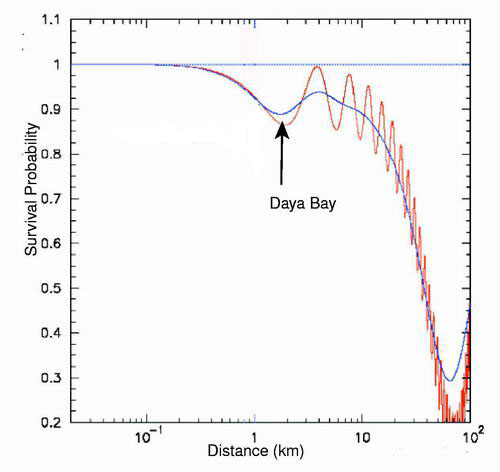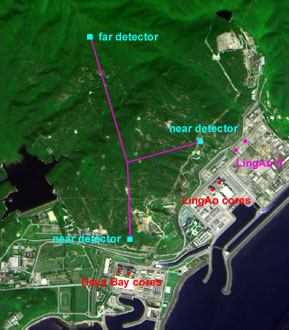The Daya Bay Anti-neutrino Experiment
About the experiment
1. Motivation
Recent discoveries have shown that neutrinos are massive. Mixing among the mass states has been observed in atmospheric and solar neutrinos in experiments such as Super-K and SNO as well as in experiments using man-made neutrino sources including KamLAND and K2K. In the neutrino mixing matrix, all but two parameters have been measured: the smallest mixing angle, q13, and the value of the CP violating phase, dCP, are not yet known. To date, the most sensitive limit on q13 is sin22q13<0.17 for Dm213 = 2.5r10-3 eV2 which was reported by the CHOOZ reactor anti-neutrino disappearance experiment with a baseline of 1.05 km.
Reactor anti-neutrino experiments have played a critical role in the 50-year-long history of neutrinos, from the discovery of the anti-neutrino by Reines and Cowan to the first observation of reactor anti-neutrino disappearance at KamLAND. The importance of reactor neutrino experiments continues to grow and the value of a measurement of sin22q13 to better than 0.01 ("1%") has been well documented. The magnitude of q13 has implications for CP symmetry breaking in the lepton sector since all physical effects of CP violation contain factors of sinq13, and the discovery of non-zero q13 will define the physics potential of future accelerator-based experiments. Observation of reactor neutrinos over a baseline of ~2 km allows the precise determination of the q13 mixing angle without ambiguities. The technical successes of both CHOOZ, and KamLAND provide the basis for a next-generation reactor neutrino experiment with significantly greater sensitivity to q13.
The goal of the Daya Bay experiment is a measurement of sin22q13 to 0.01 or better, an order of magnitude better sensitivity than the CHOOZ limit quoted above. The experiment measures the flux of anti-neutrinos from the reactors via the inverse beta-decay reaction, and any deficit from the expected 1/L2 dependence is a signature for neutrino oscillations. Inverse beta-decay consists of the capture of an electron anti-neutrino on a proton (hydrogen) resulting in the production of a positron and a neutron. The number of inverse beta-decay reactions is determined by counting the coincidence of the energy deposited by the positron (1 MeV to 8 MeV) followed by the energy released (~8 MeV) from the neutron capture on gadolinium ~30 ms later. The most serious backgrounds are from cosmic rays. The reactor complex near Daya Bay, China, about 70 km northeast of the Hong Kong airport, is an excellent site for the experiment, and one of the few appropriate sites worldwide. Accomplishing the experiment requires powerful reactors in a geological setting that allows for large underground neutrino detectors with significant overburden. Daya Bay is a nuclear power plant adjacent to high hills. The precision on sin22q13 will be improved over previous experiments by:
- Using larger detectors to increase statistics.
- Locating the detectors deeper underground to suppress background.
- Using "near" and "far" detectors suppress the systematic uncertainties related to the anti-neutrino flux from the reactor.
- Choosing optimal detector sites within the tunnel complexes to maximize the sensitivity to sin22q13.
- Carefully designed shielding around the detectors that reduces backgrounds emanating from muon interactions in the surrounding rock, including an active external muon tagging system around the detector
- Reducing the systematic error in the relative acceptance between the near and far detectors by:
- Cross calibration with the same set of passive and active radioactive sources and using characteristic energy of the signal from the capture of the neutron from the inverse beta decay reaction.
- Surrounding the central anti-neutrino target volume with a "gamma catcher", improving the energy resolution uniformity and better defining the target mass.
- Using movable detectors that can be interchanged.
- Constructing both near and far detectors from detector multiple modules of identical design.
An international collaboration between scientists from the U.S. and China have begun developing the concept for this project. We are hopeful that the viability of this experiment can be established on a short time scale, perhaps starting as early as 2007, and providing the first new information on the value of sin22q13 within three years of running.
2. Experimental Goal
The goal of the Daya Bay experiment is a measurement of sin22q13 to 0.01 or better. Figure 1 shows the survival probability for electron anti-neutrinos emitted from a nuclear reactor as a function of distance from the power plant. The rapidly oscillating (red) curve is the survival probability for mono-energetic anti-neutrinos at the peak of detected anti-neutrino energy (4 MeV), and the smoother (blue) curve accounts for the reactor anti-neutrino spectrum. The amplitude of the small oscillations corresponds to sin22q13, taken from the current CHOOZ limit.
Accounting for the 1/L2 falloff of the flux, the optimal distance for the far detector is the first maximum in the oscillation probability near 2 km. Measuring the amplitude of the oscillation, and thereby the quantity sin22q13 is the goal of the experiment. A 1% or better measurement will require high statistical precision and good measures to reduce systematic uncertainties. The presently developed experimental plan aims at both measuring the rate deficit and exploiting the spectral distortion to improve the determination of sin22q13.

Figure 1: Survival probability of reactor electron anti-neutrinos measured as a function of distance from their creation. The rapidly oscillating (red) curve is for 4 MeV anti-neutrinos, and the smoother (blue) curve accounts for the reactor anti-neutrino energy spectrum. The amplitude of the small oscillations comes from the CHOOZ limit. The large oscillation amplitude comes from KamLAND's measurement. The arrows refer to the locations of the far detector in the Daya Bay site. The value of Dm213 is taken as 2.5r10-3 eV2.
3. The Daya Bay Site
An ideal site for this experiment is at the reactor complex in Daya Bay, China. As shown in Figure 2, there are two operating power plants, Daya Bay and LingAo at this site. The plants are about 1.1 km apart. This site has the following very desirable attributes:

Figure 2: Photos showing the two presently operating reactor sites at Daya Bay. The two LingAo cores are shown on the left, and one of the Daya Bay cores is shown on the right.
- The reactor complex has a total power output of 11.6 GW (thermal), and a third power plant with an additional 5.8 GW (thermal) of power will be commissioned by 2010. With a total power of 17.4 GW (thermal), Daya Bay will very likely rank as one of the top five most powerful nuclear power plants in the world. As it operates today, it has ~50% more power than the CHOOZ experiment.
- The complex directly abuts a mountain range that can afford protection from cosmic rays that are the main source of backgrounds in the experiment. Tunnels in the mountain can provide between 100 m (mean depth of 270 meters of water equivalent) and 400 m (mean depth of 1200 mwe) of granite overburden to shield the detectors from cosmic rays, for distances between 250 m to 2.5 km from the reactor cores, respectively. A possible configuration of tunnels and detectors is shown in Figure 3.

Figure 3: Satellite photograph of the Daya Bay nuclear power plant complex showing the location of the reactors, a possible tunnel layout and possible locations for the near and far detectors. The location of the future LingAo II plant is indicated with the purple dots. Possible locations for the near and far detectors are show in light blue, connected by a tunnel in purple. In this instance the tunnel is approximately 3 km long; with other possible configurations the tunnels are between 2 km and 3 km long.
Location of Daya Bay
